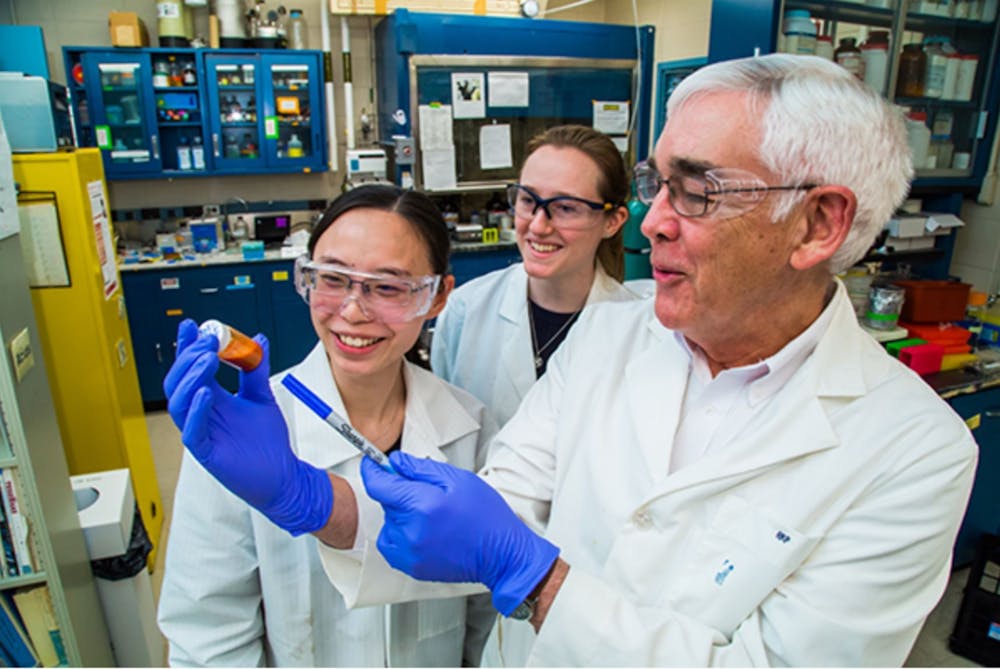Professor of chemical and biological engineering (CBE) Robert K. Prud’homme was named the inaugural recipient of the University’s Dean for Research Award for Distinguished Innovation on Oct. 30 for his invention of flash nanoprecipitation, a technology that improves the delivery of drugs throughout the body.
Prud’homme will receive the award on Nov. 5 at Engage 2020, a University conference that focuses on innovation and technology. Prud’homme will also deliver a lecture.
In an email to The Daily Princetonian, Prud’homme wrote that he was “honored to be the recipient.” He emphasized the importance of collaboration in his research.
“The award talk I want to present is not as much a description of our research, but rather a ‘thank you’ to the students, colleagues, and collaborators who enabled us to make advances in nanoparticle technology,” he wrote. “Innovation and entrepreneurship is not a solo enterprise, it requires collaborating and bringing diverse skills to the problems of nanomedicine.”
The new award is granted by the Office of the Dean for Research. It is designed to honor tenured or tenure-track faculty members whose research uses creativity and innovation to benefit humanity.
“The goals we had in mind in creating this award were to recognize the importance of innovation to Princeton, and to raise the visibility of our innovators,” wrote Pablo Debenedetti, dean for research and class of 1950 professor in engineering and applied science, in an email to the ‘Prince.’
“The criteria used to determine recipients include a demonstrated connection of the innovation to scholarly research conducted at Princeton, the creativity of the innovation in addressing a major challenge or opportunity of societal relevance, and the innovation’s demonstrated or potential impact,” he continued.
Prud’homme’s invention, flash nanoprecipitation, uses microscopic nanoparticles to protect drug molecules and target specific locations of the body as the molecules travel through the bloodstream. This is meant to encourage the slow release of drugs. The technology can be used for various medicines, including those which have been found to degrade quickly without protective measures, such as biologics.
“There are two problems we have focused on. The first is how you target drugs to specific disease sites – for example cancer tumors. Cancer drugs are highly toxic, so you want them to specifically go to the cancer site, rather [than] other tissue or organs in the body,” Prud’homme wrote.
“The second is to make oral drugs more ‘bioavailable’, that is to make more [of] the dose you take orally get into your system so that it is effective,” he continued.
Certain drugs are molecularly unable to interact with the water-filled environment of the body, necessitating a mechanism for protection to ensure accurate delivery. Prud’homme noted in his email that hearing a Pfizer vice president speak on campus 15 years ago sparked his interest in drug delivery mechanisms.
“He said that 40 percent of the new drug candidate[s] were so hydrophobic (i.e. they don’t dissolve in water or the bloodstream) that they couldn’t be effectively delivered. That started our search for [a] way to deliver them,” Prud’homme wrote.

Debenedetti highlighted the significance of Prud’homme’s research in his email.
“Professor Prud’homme has consistently found creative ways of applying his fundamental research in complex fluids to the solution of important practical problems, such as finding more efficient ways of delivering therapeutic drugs to the body, ” he wrote.
“Flash nanoprecipitation, the innovation for which he is being honored, is a perfect example: it advances science and has a range of important practical applications, including drug delivery and medical imaging,” Debenedetti continued.
Prud’homme’s contributions to the field extend beyond flash nanoprecipitation. His lab collaborates with multiple partners, including researchers at the National Institutes of Health (NIH), Argonne National Labs, and the French National Centre for Scientific Research (CNRS).
In July, Prud’homme and professor of chemistry Haw Yang began collaboration with Genentech to use flash nanoprecipitation to advance vaccine and cancer therapy delivery mechanisms.
Prud’homme’s colleagues in the Department of Chemical and Biological Engineering agree that his investigations are revolutionary.
In an email to the ‘Prince,’ Athanassios Panagiotopoulos, department chair and professor of chemical and biological engineering, wrote, “We are delighted to see Prof. Prud’homme’s outstanding research on methods to produce nanoparticles of controlled size and structure for drug delivery and imaging applications recognized by the inaugural Award for Distinguished innovation.”
“The work is an excellent example of applications of thermodynamics, kinetics, and mass transfer concepts, on which the CBE discipline is based, to solve real-world problems with potentially tremendous impact on human health,” he continued.
In the future, Prud’homme hopes to further look into biologics and the development of cost-effective drugs to be distributed around the world.
“We have two major areas in our research now and for the future. The first is the delivery of biologics ([i.e] peptides, mRNA, siRNA, proteins),” Prud’homme wrote in his email. “This is the fastest growing sector of the pharmaceutical market. We have developed a new technology that allows us to encapsulate and deliver these drugs with higher loading and efficiency [than] has ever been achieved.”
“The other area is low cost drugs for global health. Here the constraint is cost. We have worked under Bill and Melinda Gates Foundation sponsorship and our process is being implemented at a commercial scale for an anti-malarial drug for global health,” he continued.
Prud’homme received his undergraduate degree in chemical engineering from Stanford University in 1969. He went on to complete the Graduate Studies Program in Environmental Science and Public Policy at Harvard University in 1973. In 1978, he received his Ph.D in chemical engineering at the University of Wisconsin-Madison. Prud’homme joined the University’s faculty in 1978, earning the title of Professor in 1991.








